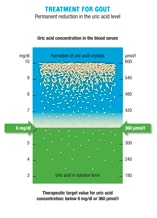How to treat gout
Gout is a chronic and multisystemic disease, meaning it can affect different parts of the body and requires lifelong treatment with regular follow-ups by your physician. In most cases, dietary adjustment is not enough to reduce uric acid levels to below 6 mg/dl (360 µmol/l), and patients need to take medication to lower uric acid levels to below the target value.
Why is it important to keep uric acid levels below 6 mg/dl?
- To stop signs and symptoms of gout
- To prevent uric acid crystal formation
- To prevent inflammation
- To reduce progressive debilitating joint and tissue damage
- To reduce the number of crystals in the body
- To reduce the likelihood of flares
- To reduce tophus formation
- To prevent gouty arthritis
- To increase dissolution of tophi
- To prevent the long-term negative effects of gout on a patient’s health and quality of life
- Halting crystal formation and eliminating existing crystals are key to preventing the long-term negative effects of gout on a patient’s health and quality of life
- Reduction of uric acid might have beneficial effects on chronic kidney disease progression and blood pressure
- Reduction of oxidative stress
Contact a doctor,
if you think you might have gout.
Lowering your uric acid level
A long-term reduction of the blood uric acid level to less than 6 mg/dl (360 µmol/l) can be sufficient to dissolve crystal deposits and avoid the formation of new crystals. This prevents acute gout attacks, and promotes the shrinkage and eventual disappearance of tophi and further tissue damage.
Whilst gout itself can be treated by lowering the uric acid level in the blood, joint and tissue damage that has already occurred may not be reversible. Treating the condition before such permanent damage occurs is therefore very important.
Uric acid lowering treatments are available to achieve the target level and reduce the associated risks. Because these medications can only be obtained on prescription, please ask your doctor which is the right treatment for you.

Treatment of gout
Our visual helps you to understand the importance of going below 6 mg/dL (360 mmol/L) in the treatment of gout.

